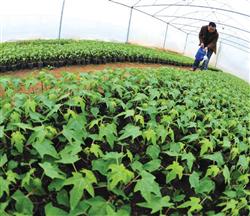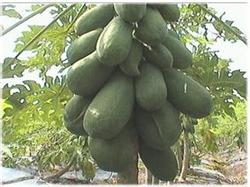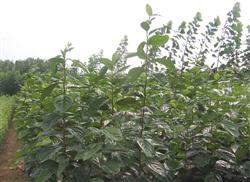Seedling raising techniques of papaya

Papaya is the dry and nearly mature fruit of Malus rosaceae, also known as wrinkled papaya. It mainly produces Shandong, Anhui, Sichuan, Hubei, Yunnan, Shaanxi and other provinces. It has the functions of relieving cough and relieving spasm, clearing summer heat and diuresis, relaxing muscles and activating collaterals, and stomach dampness. In recent years, a series of products such as papaya beverage, papaya wine, preserved fruit, canned fruit and cosmetics have been developed. Domestic and foreign markets are in short supply, and the prospect of developing papaya industry is very broad. In this paper, the techniques of seedling breeding and propagation of papaya are introduced as follows: 1. seed collection and seed treatment choose fruit trees without diseases and insect pests in the full fruit period around the middle of September every year, when most of the peel of papaya fruit turns yellow, the seeds can be picked, and the empty and shrunken seeds can be selected. then soak in 0.1-0.3% potassium permanganate aqueous solution for about 1 hour, rinse clean with clean water. Sowing directly or sowing in the spring of the following year, the method of sand storage is to mix the seeds and the net sand at 1:3, store in the open air to a cool and dry place leeward, the depth of the pit is about 50cm, if there are too many seeds, use bamboo sticks or cornstalks as "vents", the humidity of the sand should be held by hand instead of dripping, cover the sand with about 30cm, and check the storage process 2-3 times a month. Around the middle of March in the following spring, when the seed has 2/3 cleft mouth, it can begin to sow. 2. nursery land selection and preparation before sowing nursery land should be selected in brown soil or yellow loam land with convenient transportation, adequate water source, good drainage and irrigation, loose and fertile brown soil or yellow loam. Fine soil preparation should be done before sowing, and 10 kg of imported carbofuran, 5 kg of carbendazim and 15 kg of compound fertilizer should be applied per mu. Third, the flat bed strip sowing method is usually used to sow papaya, the sowing amount per mu is 30-40kg, the bed width is 120-150cm, the row spacing is 20cm, the ditch depth is 8-10cm, the soil thickness is 3-4cm, the aisle is 20-25cm, and the bottom water is irrigated after sowing. Fourth, field management papaya seedlings field management is mainly loosening soil, weeding, watering, fertilizing, as long as seeds, soil disinfection, seeds fully mature, generally no need for pest control. Weeding should be done to "remove early, small, except", avoid drought, loosen the soil regularly, fertilize the seedlings about one month after emergence, and use the ditch fertilizer method, once every half a month, applying about 15 kilograms of urea per mu for a total of 4-5 times, stop fertilizing after the beginning of autumn and promote the Lignification of seedlings. 5. Seedling grafting traditional planting seedlings often plant real seedlings, not only the yield is low, but also the variety is degraded and the economic benefit is low. Now most of the grafted seedlings are planted and begin to hang fruit in the third year. Changjun, Guohua, Luyu and other varieties selected in Shandong in recent years have strong adaptability and high yield (the yield per mu can reach more than 5000kg after high yield, with an income of nearly 10,000 yuan). The variety is excellent and can be developed and popularized in a large area. The grafting time is generally from late August to early September, usually using the method of ventral grafting of single bud, not exposing buds, checking complete healing in the spring of the following year, cutting off 2-3cm from the place of grafting, wiping buds and removing tillers in time, and strengthening management, the seedlings can grow to about 1.5m in that year, and the same method is used for a small number of those who have not survived in spring.
- Prev

High-yield cultivation techniques of papaya
Papaya belongs to the genus Chaenomeles of Rosaceae. Its fruit is rich in nutrition and has high medicinal value. In this paper, the key points of cultivation techniques for high yield papaya in field are introduced as follows: planted papaya is suitable for close planting, mountain and hilly land, plant row spacing is generally 1.5m × 3m, flat land with good fertilizer and water, plant row spacing is 2m × 3m.
- Next

How to make young persimmon trees survive the winter safely?
The cold resistance of young persimmon is poor, and the phenomenon of overwintering often occurs, so effective measures must be taken to ensure its safe overwintering. 1. Early irrigation of frozen water. Pouring enough frozen water in the middle and late October before the persimmon leaves fall and ploughing and raking a few days later can reduce the frozen layer and ensure the water needs of the roots. 2. Bury the earth to guard against the cold. Before freezing.
Related
- Moge, come on! The staff of the peasant association in the producing area of cantaloupe were frightened when the crowd gathered.
- Causes and Solutions of low Fruit setting rate of Apple
- Symptoms and control measures of passion fruit virus disease
- Fruit growing lesson: how do apple orchards keep high yields?
- Can you build orchards in the mountains? What are the pros and cons?
- How to manage the coloring period of Crisson grape?
- This paper introduces the processing technology of two kinds of fig products.
- How much is a month for retired teachers in rural areas by 2020?
- How can strawberry planting increase sugar content? We should pay attention to management in many aspects.
- What are the cultivation techniques on how to improve the yield of golden fruit?

